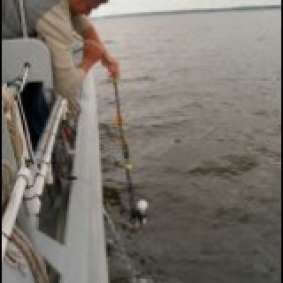Eight students will be presenting the summer work at the Ocean Sciences Meeting in March 2022!
Matthew Lusk, Longwood University
Class Year:
2005Mentor:
David Secor Ph.D.Project Title:
Effect of Environmental Conditions on the Growth, Mortality, and Recruitment of Larval Morone americana in the Patuxent River Estuary
Abstract:
Recruitment, defined as the number of individuals that reach a specific stage of the life cycle, is highly variable and largely unpredictable in fish populations. Although many studies have focused on the early life stages of fish, the mechanisms causing mortality or affecting growth, which contribute to recruitment variability, still are not clearly understood. Cohort analysis of larval white perch, Morone americana, was used to investigate the effects of environmental conditions and zooplankton density on cohort-specific vital rates and recruitment in the Patuxent River estuary (Maryland). Cohort-specific vital rates and abundances were expected to reflect the biotic and abiotic factors experienced by the cohorts. More specifically, early spawned cohorts were expected to experience lower growth rates and higher mortality due primarily to lower temperatures and storm events. Additionally, we expected cohort-specific abundance to be positively correlated with zooplankton density. Ichthyoplankton and zooplankton were collected from two stations in the Patuxent River on five dates (April to May) in 2004. Modal progression analysis based on larval length frequency distributions indicated that only two cohorts dominated the young of the year in 2004, one of which only appeared on the last two sampling dates. A comparison of continuous records of environmental variables (temperature, precipitation, dissolved oxygen, and salinity) with larval white perch abundance suggested an early season storm event, associated with a drop in temperature to approximately 10°C and substantial rainfall, resulted in high larval mortality and influenced larval white perch spatial distribution. In addition, microzooplankton densities remained sub-optimal to support white perch growth and development throughout the sampling period, which may also have been a contributing factor in cohort-specific mortality. The results of this study emphasize the importance of sampling across a wide geographical range when tracking cohorts, as weather events advecting cohorts downriver can bias mortality estimates in a narrow geographical sampling range. The uncharacteristically low number of cohorts observed in the 2004 year class was reflected in the historically low juvenile white perch abundance in 2004. This study builds on the foundation of research investigating the effects of environmental conditions and zooplankton density on larval recruitment, and contributes to our understanding of the influence of storm events on recruitment variability in the early life history of white perch.
Location:
Chesapeake Biological LaboratoryPresentations:
Lusk, M.*, and D. Secor. 2006. Effects of environmental conditions and prey availability on the growth, mortality, and recruitment of larval white perch, Monroe americana, in the Patuxent River estuary. ASLO Ocean Sciences Meeting, Honolulu, Hawaii .





